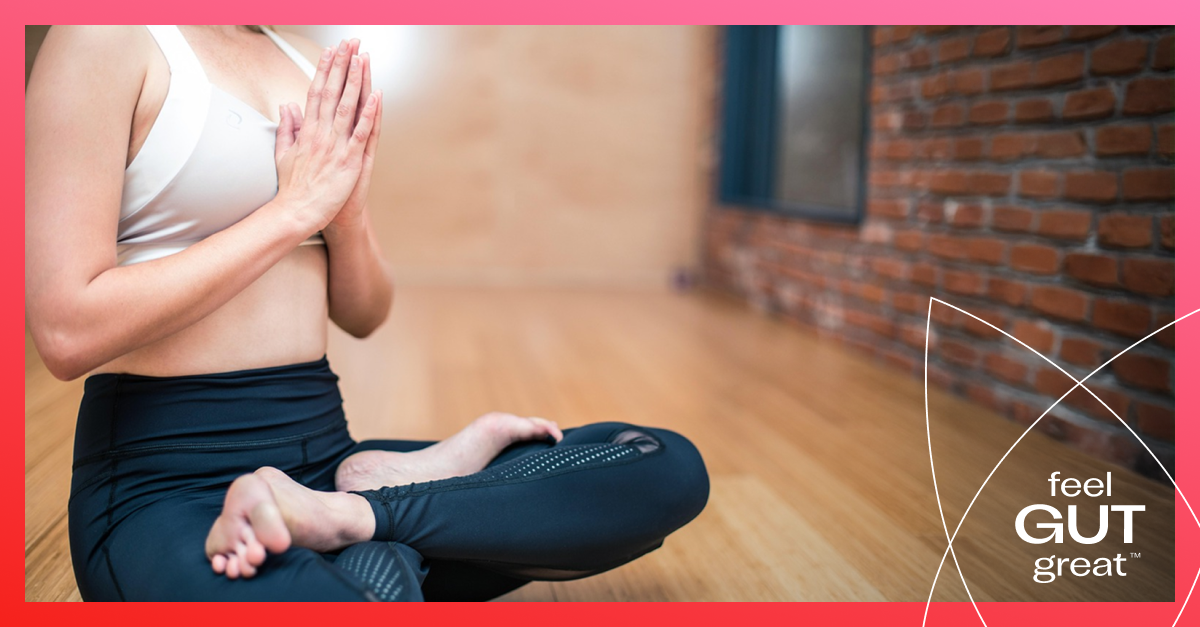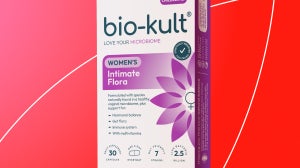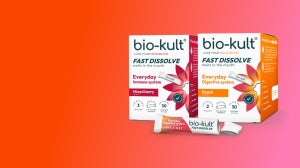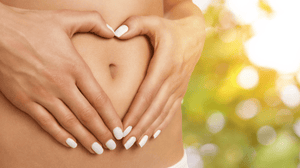
Like our gut microbiome, the vaginal microbiome is understood to be important to a woman’s overall health.1 It has been described as an intricate and dynamic microecosystem, constantly undergoing fluctuations during both the menstrual cycle and the female life cycle.2
Although many changes to the vaginal microbiome are normal and healthy, others can result in a microbial imbalance, otherwise known as dysbiosis, which is associated with negative health outcomes. Therefore, it is important to know which signs may indicate this and also what steps you can take to help restore balance.
What is the vaginal microbiome?
The community of microorganisms inhabiting the vagina plays a key role in gynaecologic wellness. However, unlike the gut, a balanced vaginal microbiome is associated with a low diversity of microbes, with certain species dominating the representation.2
This dominance appears to be so evident that women can often be categorised into one of five groups based on the composition of their vaginal microbiome. These groups are known as community state types, or CSTs.2
Why is the vaginal microbiome important?
Whilst a balanced gut microbiome is associated with a diverse composition of different species throughout the digestive tract, a balanced vaginal microbiome is understood to be dominated by Lactobacillus species.2,3
These bacteria are fundamental to vaginal function because of their ability to support reproductive health, inhibit pathogens and prevent urogenital infections.2,4,5
They do this by competing with less beneficial microorganisms for nutrients and space on the vaginal lining, producing antimicrobial compounds and lactic acid, which lowers the pH of the vaginal environment.2,6
The pH of a healthy vagina should be around 3.5–4.5, in order to have a protective effect.6,7 Pathogenic bacteria and yeasts prefer a more alkaline environment, so Lactobacilli’s ability to maintain an acidic pH promotes a healthy microbiome.2,8
How can you tell if your vaginal microbiome is out of balance?
Vaginal health is something many women struggle with at some point in their lives.
Yeast, bacterial and viral infections can be unpleasant, uncomfortable and sometimes painful. Signs that you are experiencing an infection may indicate that your vaginal microbiome has become imbalanced.2,9,10
Abnormal discharge, an unpleasant odour and irritation are all signs that your vaginal microbiome may need some extra help. Considering vaginal microbial support may also be useful for those experiencing menopausal effects, such as vaginal dryness or vaginal atrophy.11
Promoting a balanced vaginal microbiome
Supporting your vaginal microbiome begins with supporting your gut microbiome, as it is thought that many of the microbes found in the vagina will have originally migrated from the rectum.12 Therefore, increasing the amount of beneficial bacteria in the gut may help to support the microbial composition of the vagina.
Nutrition tips
Consider incorporating traditionally fermented foods and drinks into your such as kimchi, sauerkraut or kefir, as these contain beneficial species of bacteria. Alternatively, you may prefer to use a live bacteria supplement such as Bio-Kult Intimate Flora, which contains 7 friendly strains as well as vitamin E, vitamin B6, which contributes to the regulation of hormonal activity, and vitamin D, which contributes to the normal function of the immune system.
Furthermore, a typical Western diet consisting of foods that are high in sugar and saturated fats, whilst being low in fibre and micronutrients, is associated with an increased risk of microbial imbalance.13 Instead, eating a rainbow of seasonal fruit and vegetables can provide the dietary components required to promote a balanced gut and vaginal microbiome.14
Lifestyle tips
Another dietary consideration is hydration. Sufficient water intake can help to eliminate pathogens and support microbial balance.15 The vagina also requires plenty of water to function optimally, so women should aim to consume around 2 litres of water per day (with drinking water, other beverages and hydrating foods all contributing to this total).
The relationship between exercise and immune function has been well studied, suggesting that regular moderate exercise can reduce the risk of infections.16,17 More recently, research has shown that exercise can positively affect the composition of the vaginal microbiome too.18 Thus, establishing a consistent exercise routine may help to maintain or restore balance in the vagina, as well as in the gut.
Although there are many nutrition and lifestyle methods by which you can support the health of your vagina, it is important to remember that they are also good at looking after themselves. The vagina is a self-cleaning organ with its own way of promoting balance, so avoid using perfumed soaps and sanitary products or douching as this may disrupt your intimate flora.19
When to seek help
Whilst making proactive changes to support your vaginal microbiome could help to rebalance it should it become disrupted, persistent or recurring infections, odour, unusual discharge, irritation or other abnormalities could be a sign of underlying issues. If this occurs, you should consult a healthcare practitioner for a more comprehensive evaluation.
Key takeaways
Your vaginal microbiome plays an important role in supporting overall health and it is sensitive to the dietary and lifestyle choices you make on a daily basis. By appreciating this sensitivity, you can become more aware of the changes you may experience and empower yourself to manage them.
- Deka, N., Hassan, S., Seghal Kiran, G. & Selvin, J. Insights into the role of vaginal microbiome in women’s health. J Basic Microbiol 61, 1071–1084 (2021).
- Chen, X., Lu, Y., Chen, T. & Li, R. The Female Vaginal Microbiome in Health and Bacterial Vaginosis. Front Cell Infect Microbiol 11, (2021).
- Ruan, W., Engevik, M. A., Spinler, J. K. & Versalovic, J. Healthy Human Gastrointestinal Microbiome: Composition and Function After a Decade of Exploration. Dig Dis Sci 65, 695–705 (2020).
- McKloud, E. et al. Recurrent Vulvovaginal Candidiasis: a Dynamic Interkingdom Biofilm Disease of Candida and Lactobacillus. mSystems 6, 622–643 (2021).
- Malave-Ortiz, S., Calvert, M. E., Hood-Pishchany, I. & Shaw, N. D. The Vaginal Microbiome and Reproductive Health in Adolescents and Adults. J Pediatr Adolesc Gynecol 38, 117–123 (2025).
- Lewis, F. M. T., Bernstein, K. T. & Aral, S. O. Vaginal Microbiome and Its Relationship to Behavior, Sexual Health, and Sexually Transmitted Diseases. Obstetrics and gynecology 129, 643 (2017).
- Martín, R., Soberón, N., Vázquez, F. & Suárez, J. E. La microbiota vaginal: Composición, papel protector, patología asociada y perspectivas terapéuticas. Enfermedades Infecciosas y Microbiologia Clinica vol. 26 160–167 Preprint at https://doi.org/10.1157/13116753 (2008).
- France, M., Alizadeh, M., Brown, S., Ma, B. & Ravel, J. Towards a deeper understanding of the vaginal microbiota. Nat Microbiol 7, 367 (2022).
- Tortelli, B. A. et al. Associations between the vaginal microbiome and Candida colonization in women of reproductive age. Am J Obstet Gynecol 222, 471.e1 (2019).
- Orton, K. l’Cess & Monaco, C. L. The Vaginal Virome in Women’s Health and Disease. Microorganisms 13, 431 (2025).
- Brotman, R. M. et al. Association between the vaginal microbiota, menopause status, and signs of vulvovaginal atrophy. Menopause 25, 1321–1330 (2018).
- Elkafas, H., Wall, M., Al-Hendy, A. & Ismail, N. Gut and genital tract microbiomes: Dysbiosis and link to gynecological disorders. Front Cell Infect Microbiol 12, 1059825 (2022).
- Childs, C. E., Calder, P. C. & Miles, E. A. Diet and immune function. Nutrients vol. 11 Preprint at https://doi.org/10.3390/nu11081933 (2019).
- Tomova, A. et al. The Effects of Vegetarian and Vegan Diets on Gut Microbiota. Front Nutr 6, 47 (2019).
- Sato, K., Hara-Chikuma, M., Yasui, M., Inoue, J. & Kim, Y. G. Sufficient water intake maintains the gut microbiota and immune homeostasis and promotes pathogen elimination. iScience 27, (2024).
- Wang, J., Liu, S., Li, G. & Xiao, J. Exercise Regulates the Immune System. Adv Exp Med Biol 1228, 395–408 (2020).
- Gleeson, M. & Walsh, N. P. The BASES expert statement on exercise, immunity, and infection. J Sports Sci 30, 321–324 (2012).
- Song, S. D. et al. Daily Vaginal Microbiota Fluctuations Associated with Natural Hormonal Cycle, Contraceptives, Diet, and Exercise. mSphere 5, e00593-20 (2020).
- Holdcroft, A. M., Ireland, D. J. & Payne, M. S. The Vaginal Microbiome in Health and Disease—What Role Do Common Intimate Hygiene Practices Play? Microorganisms 11, 298 (2023).









